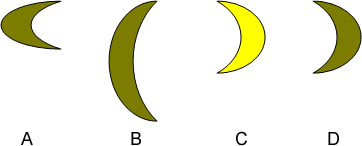Skip over navigation
1. the small circle is to C because the triangle is elongated sideways and so is C
2.the triangle is to B because the square has a quarter taken off it and so does B
3.the u-shape is to B because if you rotate the first shape 180 degrees clockwise and add the shape you on to the highest point on the right of the original shape, that will also happen with the u-shape and B

as ...

is to




Or search by topic
Number and algebra
Geometry and measure
Probability and statistics
Working mathematically
Advanced mathematics
For younger learners
Shape Mapping
Age 7 to 11
Challenge Level 





- Problem
- Getting Started
- Student Solutions
- Teachers' Resources
Several of you sent very clearly explained solutions to Shape Mapping, including Dante from Newton Prep, Jack and Jemma from Eastwood Primary, and Jamie from Great Sankey High School. Dante says:
1. the small circle is to C because the triangle is elongated sideways and so is C
2.the triangle is to B because the square has a quarter taken off it and so does B
3.the u-shape is to B because if you rotate the first shape 180 degrees clockwise and add the shape you on to the highest point on the right of the original shape, that will also happen with the u-shape and B
Fantastic! Jamie also sent in his own challenge for us:

as ...

is to

What do you think?
Can you explain why?
Thanks Jamie!
You may also like
Transformation Tease
What are the coordinates of this shape after it has been transformed in the ways described? Compare these with the original coordinates. What do you notice about the numbers?
Penta Play
A shape and space game for 2, 3 or 4 players. Be the last person to be able to place a pentomino piece on the playing board.
Patchwork Quilt
Squares of the type shown are sewn together to make a quilt. How many different quilts can be made?

